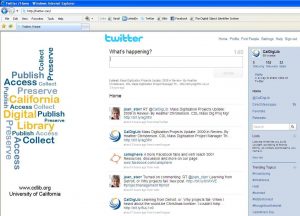How CDL’s Twitter account was born
Last October, CDL launched its official Twitter presence with a central account that channels the content of the CDLInfo newsletter and also additional content created by CDL programs and individuals that the CDL account follows. In today’s post, I’ll tell you the story of how that happened.

In early July, at a meeting of CDL project managers, we found ourselves talking about how Twitter was becoming an important communication tool in certain domains. For example, Sherri Berger mentioned that many archivists and teachers were using Twitter, and so the Digital Special Collections Program was looking into setting up an account, as were several other CDL programs. As we talked, we realized that a central CDL account could serve a key coordinating and amplifying role. In return, Twitter appeared to offer an opportunity to get CDL’s news and ideas out to a wider audience.
We soon had an informal charge from Laine Farley, our Executive Director, to explore “the medium, identifying your individual program area’s goals for involvement, developing a proposal for sharing the ongoing support, and identifying a way to assess the impact.”
We formed a small group to take up the charge. By mid-September, we had decided upon a hub-and-spokes architecture, so that CDL itself would follow only CDL program accounts and individual accounts, but could be followed by anyone (except spammers). We picked this model because we saw that other institutions like the Library of Congress were using it, and we thought it would let us keep the management of the main account simple. At the same time, we could allow for an unlimited level of complexity and granularity in the accounts that programs and services and individuals create.
We did some research and found a tool (Tweethopper) that automates the conversion of the RSS feed of CDLInfo articles into tweets (those 140-character messages Twitter allows). The same tool also has a mechanism that allows us to grant followed accounts the power to convert tweeted messages into “re-tweets” by the main account using a Twitter-to-Twitter contact format called “direct messaging.” As an aside, the Tweethopper folks have recently granted us an in-kind donation of a lifetime subscription for a single account. (Thank you, Tweethopper!)
The bottom line: we don’t have to create new content for the CDL main account. From an administration standpoint, I spend a very small amount of time each week (minutes) blocking spam followers and also watching for incoming messages that may need a reply. But, aside from that, the account is maintenance free.
In a future posting, I’ll cover how the account is working so far (activity and performance) and also our Twitter Guidelines. Meanwhile, I’m curious about the approaches of other libraries and organizations, so I hope you will post your experiences and, of course, any questions.
“See” you on Twitter!
@joan_starr
